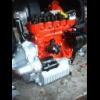
Principles Of Ignition Wiring
#1

Posted 01 August 2008 - 08:01 AM
I've just beeen trying to start Jason again since I replaced all the wiring and he isn't sparking. I could do with a decent guide to the principles behind the ignition wiring please? I have the haynes manual, but as everything is different now, it's not as much help as it needs to be.
Can you tell me what the voltage at both terminals of the coil should be when the ignition is on, but the engine is not running? I've gettin 12.8 volts across the battery and 9.1 volts at both terminals. I did think perhaps I had a fault with my rev counter that was shorting the coil, but I've taken it out and nothing has changed.
My understanding is that power goes from the starter to the coil and from the coil to the distributor and then to the spark plugs. THere are three thick wires that would normally go to the ignition switch, one is power from the starter motor (ie battery), another takes this power to the fuses and then to the rest of the electronics and the other sends power to the solenoid/starter motor to crank the car. I'm pretty sure that is all wired correctly and my understanding is correct.
Can someone describe the flow of power from the battery to the spark for me, so that I can understand where the power should be and where I could be missing a wire or something?
I need to have a good understanding so that when I get home I can fix it asap as I'm supposed to be going to the Lakes tonight!
Oh dear!
Cheers!
#2

Posted 01 August 2008 - 09:07 AM
If you've got the multimeter out, disconnect the coil leads and check the resistance of your coil - it should be 1.5Ohms on your system, but might be 3 Ohms if it's a non-ballast coil. I had the wrong one fitted to my 1985 car, and it was difficult to start... I've now got the right one on, and it starts on the button....
A brief response, but hopefully might be some help...
#3

Posted 01 August 2008 - 09:24 AM
DKLawson has made a good guide to contact breaker ignition.
#4

Posted 01 August 2008 - 11:21 AM
I haven't modified anywiring apart from the back of the dashboard, so I know that it's wired correctly between the coil, distributor, solenoid etc and its just a case of whether I've made a mistake dashboard side.
I don't think I have, but I do have a pair of red wires that run from the solenoid to the dash that I haven't connected, ignore the colours because its a non-standard loom, but I'm 99.9% sure these wires are just taking the power to the ignition, so aren't necessary with my new loom.
From what you've both said, it's looking more likely that everything is correct with the ignition and that maybe I just need to crank some fuel through as its been standing for a while, will check there's a spark when I get home, but in the mean time, keep the info coming!
Thankyou!
#5

Posted 01 August 2008 - 03:54 PM
The problem is likely to be a result of me messing with the wiring at the ignition switch, rather than a fault with the coil as it worked perfectly before I rewired everything. What do I need to do?
I feel like theres a wire missing from somewhere but I can't think where, or should the voltage drop to about 3 volts?
Help quick, I need to get it running in 2 hours max!
Cheers
#6

Posted 01 August 2008 - 04:33 PM
http://home.mindspri...tsIgnitions.pdf
Sorry, it does not discuss ballast ignition systems.
Succinctly, the ballast ignition system adds provisions for a hotter spark when you are turning the engine over on the starter motor. During starter motor operation a yellow/white wire provides system voltage directly to the coil's low-tension V(+) terminal. Once the engine starts, power is provided to the V(+) terminal through a ballast resistor (or resistor wire) to lower the coil's operating voltage.
When you measure coil voltage you have to keep in mind that current must be flowing (points closed) or the ballast resistor isn't doing anything. Closing the points is easy. Take the dizzy cap off and insert a small coin between the points, then switch on the ignition while you measure voltages. Don't forget to remove the coin later as it will keep the engine from starting.
You measured 3V at the coil when cranking but you didn't say where you measured this. What terminals were you going between? Measuring the coil's V(+) terminal and a known +12V source might very well give you a reading of 3V. Please provide details of where and how you measured 3V.
Here's a quick (and incomplete) summary of some basics.
Standard ignition:
White wire from ignition switch to coil V(+).
White/black wire between coil V(-) and the points in the distributor.
White/red wire from ignition switch to small spade lug on the solenoid
When you turn the ignition key, power travels down the white wire to the coil. When the points are closed, the current flows out the coil, down the white/black wire, through the points to earth. Also when you turn the ignition key, +12V is supplied via the white/red wire to the solenoid which closes allowing battery current to turn over the starter motor.
Ballast ignition:
Pink (resistor) wire from ignition switch to coil V(+).
White/black wire between coil V(-) and the points in the distributor.
White/red wire from ignition switch to small spade lug on the solenoid.
White/yellow wire from the solenoid back to coil V(+)
When you turn the ignition key, power travels down the pink wire to the coil. When the points are closed, the current flows out the coil, down the white/black wire, through the points to earth. The resistance of the pink wire drops the coil voltage to between 6-9V. Also when you turn the ignition key, +12V is supplied via the white/red wire to the solenoid which closes allowing battery current to turn over the starter motor. When the solenoid closes, it also passes full battery voltage to the coil V(+) terminal via the white/yellow wire.
So... when you are operating the starter, full battery voltage reaches the coil through the white/yellow wire. Once the engine starts, the white/yellow wire is turned "off" because the solenoid is no longer engaged. When the solenoid is not engaged, the coil receives reduced voltage through the pink wire.
This may not help much. If you've got a basic wiring issue, refer to your Haynes manual for specifics and the PDF above for a general overview AND its troubleshooting section.
#7

Posted 01 August 2008 - 04:35 PM
#8

Posted 01 August 2008 - 07:15 PM
Thank you for the kind words Ethel. Here's a link to my explanation on points ignitions.
http://home.mindspri...tsIgnitions.pdf
Sorry, it does not discuss ballast ignition systems.
Succinctly, the ballast ignition system adds provisions for a hotter spark when you are turning the engine over on the starter motor. During starter motor operation a yellow/white wire provides system voltage directly to the coil's low-tension V(+) terminal. Once the engine starts, power is provided to the V(+) terminal through a ballast resistor (or resistor wire) to lower the coil's operating voltage.
When you measure coil voltage you have to keep in mind that current must be flowing (points closed) or the ballast resistor isn't doing anything. Closing the points is easy. Take the dizzy cap off and insert a small coin between the points, then switch on the ignition while you measure voltages. Don't forget to remove the coin later as it will keep the engine from starting.
You measured 3V at the coil when cranking but you didn't say where you measured this. What terminals were you going between? Measuring the coil's V(+) terminal and a known +12V source might very well give you a reading of 3V. Please provide details of where and how you measured 3V.
Here's a quick (and incomplete) summary of some basics.
Standard ignition:
White wire from ignition switch to coil V(+).
White/black wire between coil V(-) and the points in the distributor.
White/red wire from ignition switch to small spade lug on the solenoid
When you turn the ignition key, power travels down the white wire to the coil. When the points are closed, the current flows out the coil, down the white/black wire, through the points to earth. Also when you turn the ignition key, +12V is supplied via the white/red wire to the solenoid which closes allowing battery current to turn over the starter motor.
Ballast ignition:
Pink (resistor) wire from ignition switch to coil V(+).
White/black wire between coil V(-) and the points in the distributor.
White/red wire from ignition switch to small spade lug on the solenoid.
White/yellow wire from the solenoid back to coil V(+)
When you turn the ignition key, power travels down the pink wire to the coil. When the points are closed, the current flows out the coil, down the white/black wire, through the points to earth. The resistance of the pink wire drops the coil voltage to between 6-9V. Also when you turn the ignition key, +12V is supplied via the white/red wire to the solenoid which closes allowing battery current to turn over the starter motor. When the solenoid closes, it also passes full battery voltage to the coil V(+) terminal via the white/yellow wire.
So... when you are operating the starter, full battery voltage reaches the coil through the white/yellow wire. Once the engine starts, the white/yellow wire is turned "off" because the solenoid is no longer engaged. When the solenoid is not engaged, the coil receives reduced voltage through the pink wire.
This may not help much. If you've got a basic wiring issue, refer to your Haynes manual for specifics and the PDF above for a general overview AND its troubleshooting section.
i havent a white/yellow wire going from my solenoid to my coil,
is that just simply putting a wire from the terminal on the solenoid to the terminal on the + coil?
thanks
#9

Posted 01 August 2008 - 07:46 PM
i havent a white/yellow wire going from my solenoid to my coil,
is that just simply putting a wire from the terminal on the solenoid to the terminal on the + coil?
you'd only have the white/yellow feed with ballasted ignition (normally says ballasted on the coil's label). If there's just a white wire on the +ve coil terminal I wouldn't worry about it.
Paul,
3 volts at the coil doesn't sound like you'll get much of a spark. Measuring the coil's resistance (across the LT terminals) sounds like a good place to start. You could also check the resistance of the coil's supply by measuring the resistance between the +ve terminal and Position 2 of the ignition switch, or an ignition dependent fuse.
It sounds like you have a ballasted system but no cranking feed to bypass ballasted one. Particularly if the starter spins over well.
#10

Posted 01 August 2008 - 08:09 PM
i havent a white/yellow wire going from my solenoid to my coil,
is that just simply putting a wire from the terminal on the solenoid to the terminal on the + coil?
you'd only have the white/yellow feed with ballasted ignition (normally says ballasted on the coil's label). If there's just a white wire on the +ve coil terminal I wouldn't worry about it.
Paul,
3 volts at the coil doesn't sound like you'll get much of a spark. Measuring the coil's resistance (across the LT terminals) sounds like a good place to start. You could also check the resistance of the coil's supply by measuring the resistance between the +ve terminal and Position 2 of the ignition switch, or an ignition dependent fuse.
It sounds like you have a ballasted system but no cranking feed to bypass ballasted one. Particularly if the starter spins over well.
i must have a ballast system(converted probably)
i have a terminal on the solenoid that has nothing to it! is this where a wire should go from solenoid to + coil? the yellow/white wire?
i have a pink/white wire going to other terminal on solenoid
#11

Posted 01 August 2008 - 08:20 PM
Any markings on the coil to give us a clue, that's what really matters.
Most solenoids have a suitable connection even if it isn't used. I suppose it wouldn't hurt to connect it to the coil, it will just be surplus to requirements if it isn't a ballasted system. Make sure the terminal you use on the solenoid is only live when you're cranking the engine - i.e. dead when just the ignition is switched & connect it to the +ve terminal of the coil: the same as the pink/white. The terminal is usually in the middle, opposite the one that operates the solenoid & starter.
#12

Posted 01 August 2008 - 08:33 PM
Do you mean pink/white on the coil?
Any markings on the coil to give us a clue, that's what really matters.
Most solenoids have a suitable connection even if it isn't used. I suppose it wouldn't hurt to connect it to the coil, it will just be surplus to requirements if it isn't a ballasted system. Make sure the terminal you use on the solenoid is only live when you're cranking the engine - i.e. dead when just the ignition is switched & connect it to the +ve terminal of the coil: the same as the pink/white. The terminal is usually in the middle, opposite the one that operates the solenoid & starter.
hi just taken a look
sorry i have a white/red wire going to solenoid
BUT i have not got a pink/white wire going to + coil!
unfortunately no stickers on coil, it has 12v on it, bup i think on one terminal, i can check the rest if that helps?
but i think i need to wire in this pink/white wire?
#13

Posted 01 August 2008 - 08:41 PM
reading USE WITH BREAKERLESS IGNITION
#14

Posted 01 August 2008 - 09:04 PM
How many (thin) wires go from the coil to the distributor?
#15

Posted 01 August 2008 - 09:09 PM
Mark and remove the low-tension wires from the coil.
Place your meter in Ohms mode to measure resistance and place the meter leads across the coil's low tension terminals.
(AGAIN... no wires should be on the low tension coil terminals during this test)
If you measure close to 3 Ohms, you have a standard coil. If you measure 1 to 2 Ohms you have a ballast coil.
Find the wire going to the coil from the ignition switch.
(What color is it? The feed wire to a standard coil is "white", the feed to a ballasted coil is "pink". )
Reconnect ONLY the ignition switch feed wire to the coil V(+) .
Connect a jumper wire between the coil's V(-) terminal and earth.
Switch on the ignition. Measure between coil V(+) and earth. Tell us what voltage you measure.
(A standard ignition will have coil V(+) at 12V, a ballast system will show 6-9 volts on coil V(+). )
If you haven't read the PDF link on points ignition systems please do so.
1 user(s) are reading this topic
0 members, 1 guests, 0 anonymous users















